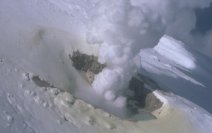
February Editorial
Monitoring Volcanoes

February Editorial
Monitoring Volcanoes
|
|
Previous editorials have discussed volcanic eruptions and the dangers associated with them. These do not only affect those living nearby - there are other dangers, for instance to aviation. Volcanic ash constitutes a serious hazard to jet aircrafts since ash blowing into engines can shut them down in mid air. Since airbourne ash can travel a considerable distance, monitoring volcanic activities is very important. There are numerous agencies which around the world which do this, and next month's editorial will discuss the growing number of methods for studing volcanoes and ash emissions. Here we focus on one of these agencies - The Alaska Volcano Observatory, or AVO in short. AVO was formed in 1988 as a joint program of the United States Geological Survey (USGS), the Geophysical Institute of the University of Alaska Fairbanks (UAFGI), and the State of Alaska Division of Geological and Geophysical Surveys (ADGGS). Initially, AVO monitored just four Cook Inlet volcanoes which were the closest to Alaskan population centers. In 1996 the program expanded to include an additional 16 volcanoes in the Aleutian Islands and on the Alaskan Peninsula. The main aims of AVO are, firstly, to study the nature, timing, and likelihood of volcanic activity; secondly, to assess volcanic hazards and thirdly to provide local, state, and federal officials as well as the public with up-to-date information and warnings of impending dangerous activity. Reports on each of the monitored volcanoes can be found on the AVO website which contains a wealth of other useful information including background information about these volcanoes. The library contains information about all Alaska’s volcanoes, geological maps, volcano seismicity catalogues and other related geospatial data. AVO also provides three different types of reports all of which are available from their site – both up to date reports and archives dating back to 1997. The information in the reports is colour coded – the colours referring to the level of volcanic activity. The colour codes and the definitions are listed below and have been taken directly from the AVO website. The three different types of report are: daily reports describing the status of all Alaskan volcanoes with elevated colour codes; periodic reports providing more detailed information about each of the volcanoes; weekly reports giving seismic activity of the volcanoes. For those interested in volcanoes the AVO site is definitely worth a visit.
|
| _______________________________ | ||||
| Home | | | Shopping | | | Database |
© Biscuit Software 2004-2015
All rights reserved